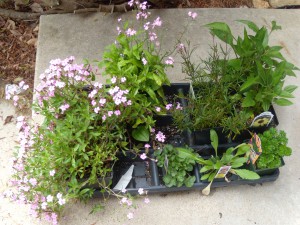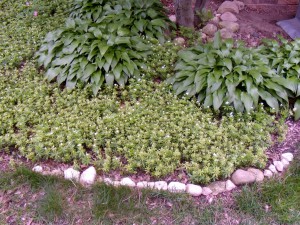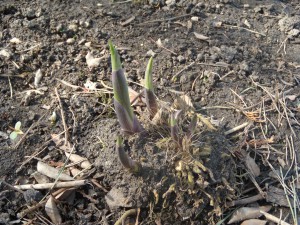Judybusy and I were chatting in the comments section last week about good neighbors. Judybusy has That Damn Nancy (so named because her garden always looks “pristine”). Neighbors like that really help you raise the level of your own game. And if they’re nice in the bargain, it’s a bonus.
At our previous place, we were blessed with two such neighbors. Alice and Joan were extraordinary gardeners, generous with their advice, quick to praise my triumphs and gentle with their criticisms. Alice educated me about the horrors of buckthorn and introduced me to the joy of bleeding hearts. The three of us swapped plants and stories over the fence.
Their husbands were equally wonderful. When we fond a ceiling leak in our basement bathroom, Alice’s husband, then well into his 70s, came right over and helped my husband pull the upstairs toilet and replace the seal—a task my spouse would never, ever have undertaken on his own. (I don’t even let him handle a power drill.) Joan’s husband brought us the surplus from their strawberry-picking expeditions every July and delivered her exquisitely crafted Christmas cookies every December.
Both couples were generous with our children, too, always chatting them up, telling us what great kids they were, slipping them small gifts here and there, giving them a few bucks for their graduations. We would’ve been lucky just to get to know them. Having them as neighbors was a gift.
The neighbor whose back yard bordered ours was a little more prickly, complaining when one of my daylilies sent up a sprout in her yard on the other side of the chain-link fence. She once called the local constabulary to complain that our cats were pooping in her flowerbeds. A village cop came to our door, sheepishly informed me about the complaint, and pointed out that if he got another one, they’d have to come and corral our wayward felines. (He seemed embarrassed by the whole thing; I don’t think he made eye contact at all beyond his initial “Hello, ma’am.”) After that, we made a valiant effort to keep our cats from fleeing the house. Alice and Joan were horrified by this story; they were convinced our cats were keeping the neighborhood rodents out of our houses, because they’d had this problem before we moved in, and never since. As soon as we corralled the cats, both their houses were plagued with chipmunks in the basements. (If Backyard Neighbor had this problem, she never let on.)
In our new place, we’ve had no problem whatsoever with our neighbors…except the ones whose backyard abuts ours. It started when the man of the house pulled up in our driveway and marched up to the door to announce that our son’s drumming was hampering their ability to watch TV. Yes, you can hear the drums from outside, but are you kidding me? He apparently got up from his spot in front of the TV, drove around the block (which took him twice as long as it would have to just walk across the back yard), parked in my driveway and rang the doorbell to impart this news. Oddly, he had a bluetooth headset firmly planted in one ear—to better allow his spouse to hear our conversation, I suspect. I was furious, but kept my calm and told him I’d tell the kid to keep it down.
(A bit of explanation: The kid does have a drum kit. It is in the back of the house, although it’s below ground level. Yes, a certain amount of sound drifts outdoors. But we keep all the windows and doors closed when he plays, and he never plays after 6 p.m., and never for more than 30 minutes. Folks, get a grip.)
Fast-forward to last weekend. A tornado watch was in effect, and the wind gusts were so fierce I didn’t feel entirely safe working in the back yard, where we have more than a dozen trees, many of them prone to dropping limbs when the wind is howling. I look out across the patio, and there is Backyard Neighbor, spraying weed killer on the slope behind his own patio. I don’t know what he was using, but it was a serious device—a long cylindrical tank with an attached hose and sprayer. The winds had to have been gusting to 30 mph or more. I could not believe my eyes. Has this man never heard of chemical drift? (He wasn’t wearing a mask or gloves, either.)
I was still watching in amazement when a profound chemical stench came drifting through the patio doors and into the dining room, where I was minding my own business with a bowl of soup. I could only grimace and hope he wasn’t killing anything in my yard, but who knows where that stuff ended up?
Now I think I know. My largest bed of sweet woodruff, which sits haplessly downwind of his spraying zone, has gone from vibrant green to sickly yellow, and some of the leaves are blackened and scorched around the edges.
As soon as I closed the patio door on Saturday and explained the situation to my son, he said, “That jerk. I’m going downstairs to play drums.”
I can’t say that I’m sorry.




